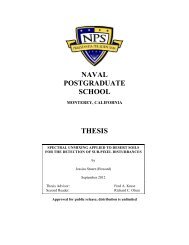October 2000 Newsletter - Naval Postgraduate School
October 2000 Newsletter - Naval Postgraduate School
October 2000 Newsletter - Naval Postgraduate School
You also want an ePaper? Increase the reach of your titles
YUMPU automatically turns print PDFs into web optimized ePapers that Google loves.
FEATURED PROJECT<br />
MICRO-AIR VEHICLE AERODYNAMICS, continued from page 44<br />
motion rather than a single degree of freedom pitch or plunge motion. This<br />
expands the parameter space considerably. In addition to the pitch and plunge<br />
amplitudes one now has to consider the phase angle between the pitch and plunge<br />
motions. It is important to realize that the key parameter for determining whether<br />
an airfoil generates thrust or extracts power from a flow is the effective angle of<br />
attack, as illustrated in Figure 7. Cases (a) and (b) represent the pure plunge and<br />
pitch modes. Case (c) is the neutral case (pure feathering) between thrust generation<br />
and power extraction. A negative effective angle of attack (relative to the<br />
flight path) leads to thrust generation, case (d), a positive angle to power extraction,<br />
case (e).<br />
Interference Effects<br />
As already mentioned, Schmidt (1965) sought to develop an efficient flapping foil<br />
propeller by exploiting the interference<br />
effect between a flapping<br />
fore-wing and a non-flapping<br />
hind-wing. The stationary hindwing<br />
is exposed to an oscillatory<br />
flow and therefore can exploit the<br />
Katzmayr effect, i.e., convert the<br />
vortical energy generated by the<br />
Figure 8: Numerical and experimental<br />
configurations.<br />
either a pure plunge mode or a combined pitch/plunge mode<br />
with the optional mounting of two stationary hind-wings as<br />
shown in Figure 8d.<br />
The Flapping-Wing Micro-Air Vehicle<br />
As a result of the experimental and computational investigations<br />
performed on the tandem configuration (Figure 8b) and the<br />
biplane configuration (Figure 8c), we have concluded that the<br />
latter configuration is the most promising one. Therefore, we have<br />
adopted the modification, shown in Figure 8e, for mechanical<br />
--continued on page 46<br />
Figure 7: Effective versus geometric<br />
AoA.<br />
flapping fore-wing into additional thrust. Two arrangements are of greatest<br />
interest, namely the tandem and the biplane arrangement, shown as Figures 8b<br />
and 8c, respectively. Visit www.aa.nps.navy.mil/~jones/research/unsteady/<br />
panel_methods/anim3/ and www.aa.nps.navy.mil/~jones/research/unsteady/<br />
panel_methods/anim2/ to see animated simulations of these configurations.<br />
The latter arrangement is equivalent to a single airfoil oscillating in ground<br />
effect provided the oscillation of the two airfoils in the biplane arrangement<br />
occurs in counter-phase. We performed a detailed computational and experimental<br />
investigation of both arrangements. To this end the model shown in<br />
Figure 9 was built<br />
and tested which<br />
allowed the<br />
flapping of the<br />
two fore-wings in<br />
Figure 9: Isometric view of the large model.<br />
NPS Research page 45<br />
<strong>October</strong> <strong>2000</strong>
















